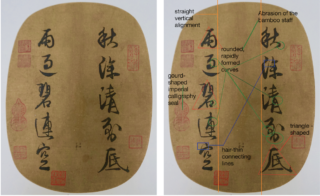February 13, 2018 / Laura Vermeeren
Waving the Wind: Fan calligraphy by Emperor Lizong

In the humid capital of Hangzhou in the eleventh century, many carried around a fan
to wear off the summer heat. The fan served as a personal accessory much like how
we wear a scarf today. Often painted on one side and inscribed with an accompanying
poem in elegant calligraphy on the other, these objects can be considered a portable
piece of art. Because they were carried so close to the body and displayed outside of
the house one can imagine them serving almost as a personal billboard of the
inscriber’s art. According to Harrist Jr., the practice of inscribing fans has been traced
back to the Han Dynasty (206 BC-AD 220), but the great age of fan painting, in
particular the screen-type fan began in the Northern Song and continued through the
Southern Song (1127-1279). Weitz estimates the annual production of painted fans
during the Southern Song in the millions, arguing that “ everyone in the social
hierarchy” used one. Knowing this it should come as no surprise that the imperial
family during the Southern Song too occupied themselves with inscribing fans,
bestowing them as gifts to ministers, friends, relatives and concubines.
This article examines the imperial calligraphy of Emperor Lizong (1205-1264) of the
Southern Song, written down on two hand held fans. These fans a part of the John M.
Crawford Jr Collection and can be admired in the MET museum in New York,
currently not on view. Of all Southern Song imperial calligraphy after emperor
Gaozong(1107-1187), Emperor Lizong’s calligraphy is regarded as the one
expressing the most striking individual style.3 Intrigued by this, I wonder what made
emperor Lizong stand out. In a climate where following the two Wangs was the
imperial norm for hundreds of years, how is it possible that Lizong managed to write
so distinctively? Why doesn’t his style resemble more of what his predecessors did?
Are there political and aesthetic motivations for this change in style, who influenced
him and can we start to analyse what in his style makes him so highly esteemed as a
Southern Song imperial calligrapher? Does the intimate nature of the round object on
which the calligraphy was written make a difference as to how he wrote, and is there a
correlation between the choice of poetry subject and the way Emperor Lizong penned
them down? In other words, does the object change the writing?
Starting with a brief introduction on the social context of imperial writing in
the Southern Song and the societal and imperial circumstances that made up Emperor
Lizong’s milieu, the article explores the features of Song Lizong his calligraphy and
attempts to place his mode of writing in the context of Southern Song imperial
calligraphy.
1. Writing at court
Lizong was born to later become the fifth emperor of the Southern Song dynasty
(1127- 1279). By that time, the tone for a calligraphic ideal had been long set.
McNair notes that “the imperial choice of a calligraphic model had already been
firmly established for more than five hundred years”. We have to go back to the
Eastern Jin (265 -420) dynasty, when a distinct culture of calligraphy took shape.5 It
is hard to overstate the influence of two calligraphers of that time in the establishment
of that calligraphic tradition: Wang Xizhi (303-361) and his son Wang Xianzhi (344-
386) often referred to as ‘ the two Wangs’. Born in the Eastern Jin dynasty, Wang
Xizhi’s calligraphic accomplishments had been acknowledged already in his time, and
from then onwards imperial collectors sought to collect and promote the style of the
two Wangs at court, culminating in Tang Emperor Taizong’s ( r. 626-649) obsessive
enthusiasm for Wang Xizhi’s calligraphic style. After his conquest of the South,
emperor Taizong used calligraphy as a means to create social unity. The emperor,
based in the North, hoped to gain the acceptance of the Chinese elite by promoting a
classical tradition of calligraphy that originated in the South. This was a success;
McNair notes that Emperor Taizong of the Tang fixed the style of Wang Xizhi as the
imperial signature with such finality that it was maintained through the Tang dynasty
and beyond.8 By the time the Song dynasty (960-1279) consolidated its rule, the
imperial calligraphy collections had also been moved to their court. We can see
Emperor Taizong of Song (939-997) repeating the same pattern as his namesake
centuries earlier: promoting the style of the two Wangs to legitimize his rule. He did
so by appointing a late descendant of Wang Xizhi, Wang Zhu, as the court instructor
as well as instructing the calligraphers of the Hanlin academy to practice Wang’s
style. Additionally, Taizong acquired more writings from the two Wangs from
conquered courts and he ordered re-engravings of a selection of calligraphy made by
Wang Zhu, made up largely of letters attributed to Wang Xizhi and his son. It is this
corpus of writing that formed the largest bulk of the imperial collection.
When the Jin Dynasty attacked the Song, Emperor Gaozong (1107-1178) was
forced to move south, now ruling the Southern Song, which took as its capital present
day Hangzhou. It is here that four generations of emperors would, as Fong maintains,
create a new dynastic style in Southern Song calligraphy10. Although previously
influenced by more contemporary calligraphers of that time that wrote in an
individualistic style such Huang Tingjian (1045- 1105), and later Mi Fu (1051-1107),
Emperor Gaozong changed his style and returned to modelling after the two Wangs in
1130. Gaozong’s promotion of the style of the two Wangs was so effective that the
next four generations of emperors Xiaozong, Ningzong, and his empress Yang Meizi
and finally Lizong all wrote in “ a strikingly homogenous style”. Chu Hui-Liang
notes that they were similar to the extent that later collectors and connoisseurs found
great trouble in attributing the extant writings. All modelled after the two Wangs and
usually not signed, it occurred that hand scrolls and fans have been attributed to the
wrong emperor.
Below you see an example of this homogenous style on three fans written by Emperor
Gaozong, Emperor Xiaozong and Empress Yang Meizi respectively with a sort visual
analysis of Wang Xizhi’s impact on their writing style.


